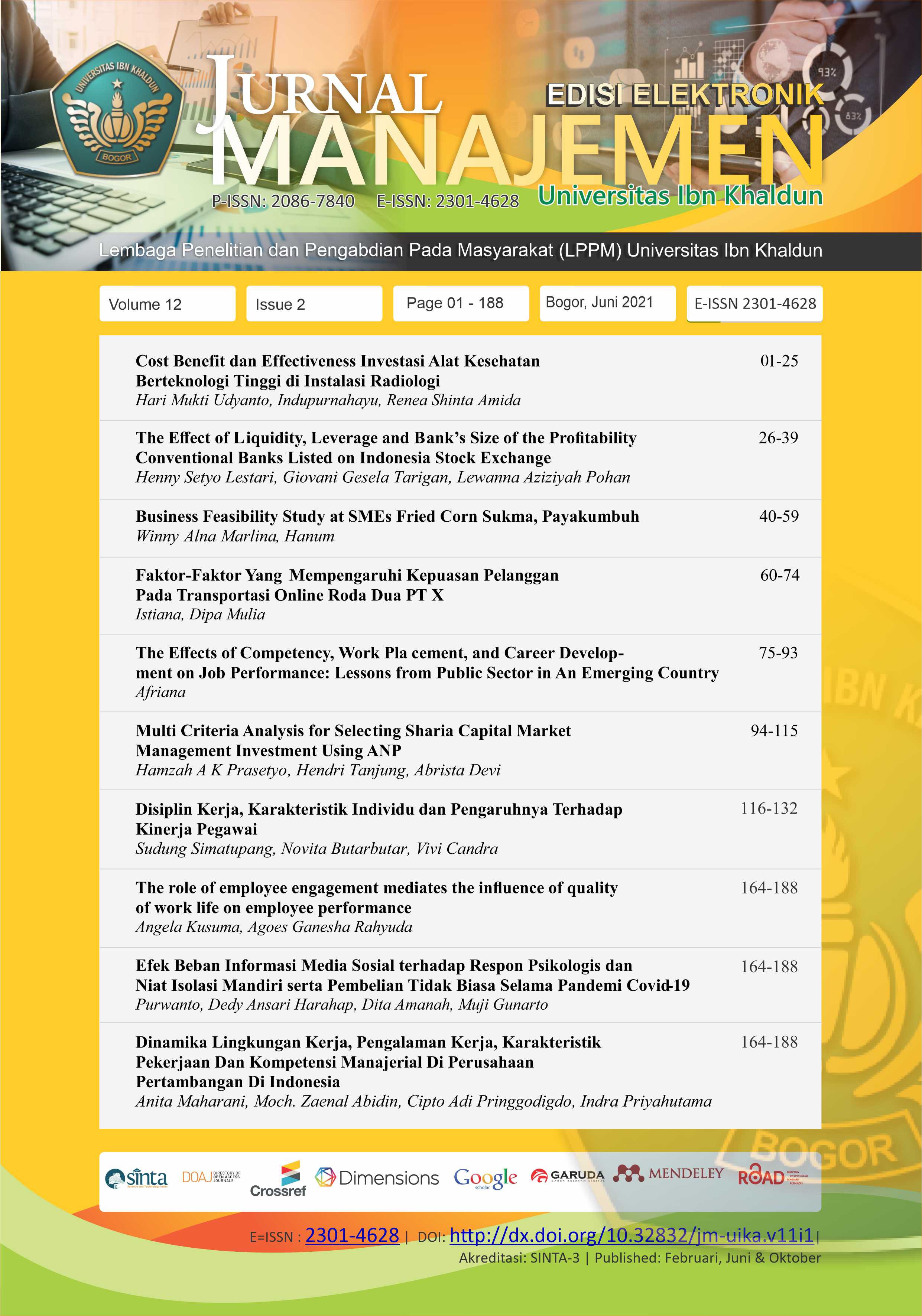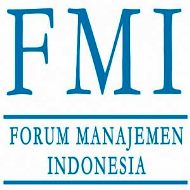Beban Infomasi Media Sosial Dan Niat Melakukan Isolasi Mandiri serta Panic Buying Selama Pandemi Covid 19
DOI:
https://doi.org/10.32832/jm-uika.v12i2.4327Keywords:
Kelebihan beban informasi, persepsi keparahan, cybercondria, pembelian panic buying.Abstract
Selama pandemi COVID-19, terjadi perilaku konsumen yang tidak biasa, seperti membeli kebutuhan pokok dalam jumlah besar. Peneliti menyelidiki perilaku ini saat ketakutan akan gangguan pasar konsumen mulai beredar, untuk mengetahui perilaku manusia dalam situasi yang unik ini. Berdasarkan kerangka stimulus-organisme-respons (SOR), konstruksi model struktural yang menghubungkan pajanan sumber informasi online (stimulus lingkungan) dengan dua respons perilaku: pembelian yang tidak biasa dan isolasi diri sukarela. Untuk menguji model yang diajukan, kami mengumpulkan data dari 236 responden di Indonesia melalui survei online, dan melakukan analisis menggunakan PLS-SEM. Hasil analisis menemukan hubungan yang kuat antara niat diri untuk mengisolasi diri dan niat untuk melakukan pembelian yang tidak biasa, dan memberikan bukti empiris bahwa perilaku konsumen yang dilaporkan terkait langsung dengan perkiraan waktu yang dihabiskan untuk isolasi diri. Lebih lanjut, hasil penelitian menemukan kelebihan beban informasi merupakan prediktor kuat cyberchondria. Persepsi keparahan situasi dan cyberchondria berdampak signifikan terhadap niat orang untuk melakukan pembelian yang tidak biasa dan melakukan isolasi diri secara sukarela. Penelitian di masa depan diperlukan untuk memastikan efek jangka panjang pandemi terhadap layanan konsumen dan ritel.
References
Daftar Pustaka
Aiken, M., Kirwan, G., Berry, M., & O'Boyle, C.A., (2012). The age of cyberchondria. Roy. Coll. Surg. Ireland Student Mediteran Journal, 5 (1), 71–74.
Anderson, R.M., Heesterbeek, H., Klinkenberg, D., & Hollingsworth, T.D., (2020). How will country-based mitigation measures influence the course of the COVID-19 epidemic? Lancet 395 (10228).
Attiq, S., Rasool, H., & Iqbal, S. (2017). The impact of supportive work environment, trust, and self-efficacy on organizational learning and its effectiveness: a stimulus organism response approach. Business Economic Review, 9 (2), 73–100.
Balinska, M., & Rizzo, C. (2009). Behavioural responses to influenza pandemics: what do we know? PLoS Curr, 1.
Barclay, D., Higgins, C., & Thompson, R., (1995). The partial least squares (PLS) approach to causal modeling: personal computer adoption and use as an illustration. Technology Studies. (2), 285–324, 2.
Bartik, A.W., Bertrand, M., Cullen, Z.B., Glaeser, E.L., Luca, M., & Stanton, C.T., 2020. How Are Small Businesses Adjusting to COVID-19? Early Evidence from a Survey. National Bureau of Economic Research.
Brug, J., Aro, A.R., & Richardus, J.H. (2009). Risk Perceptions and Behaviour: towards Pandemic Control of Emerging Infectious Diseases.
Bults, M., Beaujean, D.J., Richardus, J.H., & Voeten, H.A. (2015). Perceptions and behavioral responses of the general public during the 2009 influenza A (H1N1) pandemic: a systematic review. Disaster Medicine Public Health Preparedness, 9 (2), 207–219.
Dhir, A., Yossatorn, Y., Kaur, P., & Chen, S. (2018). Online social media fatigue and psychological wellbeing”a study of compulsive use, fear of missing out, fatigue, anxiety and depression. Internatioal Journal Information Management, 40, 141–152.
Dhir, A., Kaur, A., Chen, S., & Pallesen, S. (2019). Antecedents and consequences of social media fatigue. Internatioal Journal Information Management, 48,193–202.
Farooq, A., Laato, S., & Islam, A.N. (2020). Impact of online information on self-isolation intention during the COVID-19 pandemic: cross-sectional study. Journal Mediteran Internet Research, 22 (5), e19128.
Floyd, D.L., Prentice-Dunn, S., & Rogers, R.W. (2000). A meta-analysis of research on protection motivation theory. Jornal Applied Social Psychology, 30 (2), 407–429.
Fornell, C., & Larcker, D.F. (1981). Structural equation models with unobservable variables and measurement error: algebra and statistics. Journal Marketing Research, 18, 382–388.
Gamma, A.E., Slekiene, J., & Mosler, H.J. (2020). The impact of various promotional activities on Ebola prevention behaviors and psychosocial factors predicting Ebola prevention behaviors in the Gambia evaluation of Ebola prevention promotions. International Journal Environment Research Public Health, 16 (11), 2020.
Gamma, A.E., Slekiene, J., von Medeazza, G., Asplund, F., Cardoso, P., & Mosler, H.J. (2017). Contextual and psychosocial factors predicting Ebola prevention behaviours using the RANAS approach to behaviour change in Guinea-Bissau. BMC Public Health 17 (1), 446.
Gao, L., & Bai, X. (2014). Online consumer behaviour and its relationship to website atmospheric induced flow: insights into online travel agencies in China. Journal Retailing Consumer Service. 21 (4), 653–665.
Google, (2020). COVID-19 community mobility reports [ONLINE] available at. https://www.google.com/covid19/mobility/, akses 16 Mei, 2020.
Goodhue, D.L., Lewis, W., & Thompson, R.L. (2012). Does PLS have advantages for small sample size or non-normal data? MIS Quarter 36 (3), 891–1001.
Goodwin, R., Haque, S., Neto, F., & Myers, L.B. (2009). Initial psychological responses to Influenza A, H1N1 ("Swine flu"). BMC Infectious Diseases, 9 (1),166.
Jokic-Begic, N., Mikac, U., Curzik, D., & Jokic, C.S. (2019). The development and validation of the short cyberchondria scale (SCS). Journal Psychopathology Behavior Assessment, 41 (4), 662–676.
Joshi, Y., & Rahman, Z. (2015). Factors affecting green purchase behaviour and future research directions. Int. Strategic Management Review, 3 (1–2), 128–143.
Laato, S., Islam, A.N., Islam, M.N., & Whelan, E. (2020). What drives unverified information sharing and cyberchondria during the COVID-19 pandemic? Europe Journal Information System, 1–18.
La Torre, G., Di Thiene, D., Cadeddu, C., Ricciardi, W., & Boccia, A. (2009). Behaviours regarding preventive measures against pandemic H1N1 influenza among Italian healthcare workers. October 2009 Euro Surveill, 14 (49), 19432.
Lee, A.R., Son, S.M., & Kim, K.K. (2016). Information and communication technology overload and social networking service fatigue: a stress perspective. Computer Humanization Behavior, 55, 51–61.
Lupien, S.J., & Lepage, M. (2001). Stress, memory, and the hippocampus: can't live with it, can't live without it. Behavior Brain Research, 127 (1–2), 137–158.
Leung, C.C., Lam, T.H., & Cheng, K.K. (2020). Mass masking in the COVID-19 epidemic: people need guidance. Lancet, 395 (10228).
Ling, M., Kothe, E.J., & Mullan, B.A. (2019). Predicting intention to receive a seasonal influenza vaccination using Protection Motivation Theory. Social Science Medicine, 233, 87–92.
Kelman, H.C., (1958). Compliance, identification, and internalization three processes of attitude change. Journal Conflict Resolution, 2 (1), 51–60.
Kothe, E.J., Ling, M., North, M., Klas, A., Mullan, B.A., & Novoradovskaya,L. (2019). Protection motivation theory and pro-environmental behaviour: a systematic mapping review. Australia Journal Psychology 71 (4), 411–432.
Maddux, J.E., & Rogers, R.W., (1983). Protection motivation and self-efficacy: a revised theory of fear appeals and attitude change. Journal Experience. Social Psychologic, 19 (5), 469–479.
Malik, A., Dhir, A., Kaur, P., & Johri, A. (2020). Correlates of Social Media Fatigue and Academic Performance Decrement. Information Technology & People.
Mehrabian, A., & Russell, J.A., (1974). An Approach to Environmental Psychology. the MIT Press.
Miri, S.M., Roozbeh, F., Omranirad, A., & Alavian, S.M. (2020). Panic of buying toilet papers: a historical memory or a horrible truth? Systematic review of gastrointestinal manifestations of COVID-19. HepatMon, 20 (3).
Morahan-Martin, J.M. (2004). How internet users find, evaluate, and use online health information: a cross-cultural review. Cyberpsychology Behavior, 7 (5), 497–510.
Maital, S., & Barzani, E. (2020). The Global Economic Impact of COVID-19: A Summary of Research. Samuel Neaman Institute for National Policy Research.
Milne, S., Sheeran, P., Orbell, S., 2000. Prediction and intervention in health-related behavior: a meta-analytic review of protection motivation theory. Journal Applied Social Psychologic, 30 (1), 106–143.
Oinas-Kukkonen, H., (2013). A foundation for the study of behavior change support systems. Personal Ubiquitous Computer, 17 (6), 1223–1235.
Parmet, W.E., & Sinha, M.S. (2020). Covid-19”the law and limits of quarantine. N. Englland Journal Medicine, 382 (15), e28.
Rogers, R.W. (1975). A protection motivation theory of fear appeals and attitude change. Journal Psychologic, 91 (1), 93–114.
Rubin, G.J., Amlot, R., Page, L., & Wessely, S. (2009). Public perceptions, anxiety, and behaviour change in relation to the swine flu outbreak: cross sectional telephone survey. BMJ, 339, b2651.
Ruthig, J.C. (2016). Health risk perceptions and exercise in older adulthood: an application of protection motivation theory. Journal Applied Gerontology, 35(9), 939–959.
Sharifirad, G., Yarmohammadi, P., Sharifabad, M.A.M., & Rahaei, Z. (2014). Determination of preventive behaviors for pandemic influenza A/H1N1 based on protection motivation theory among female high school students in Isfahan, Iran. Journal Education Health Promotion, 3.
Shou, B., Xiong, H., & Shen, X.M. (2013). Consumer panic buying and quota policy under supply disruptions. In: Working Paper. City University of Hong Kong, Hong Kong.
Starcevic, V., & Berle, D. (2013). Cyberchondria: towards a better understanding of excessive health-related Internet use. Expert Review Neurother, 13(2), 205–213.
Sweller, J. (2011). Cognitive load theory. In: Psychology of Learning and Motivation, vol. 55. Academic Press, pp. 37–76.
Talwar, S., Dhir, A., Kaur, P., Zafar, N., & Alrasheedy, M. (2019). Why do people share fake news? Associations between the dark side of social media use and fake news sharing behavior. Journal Retailing Consumer Service, 51, 72–82.
Talwar, S., Dhir, A., Singh, D., Virk, G., & Salo, J. (2020). Sharing of fake news on social media: application of the honeycomb framework and the third-person effect hypothesis. Journal Retailing Consumer Service. 52, 42-54.
Timpka, T., Spreco, A., Gursky, E., Eriksson, O., Dahlstro€m, OE., Stroemgren, M., & Holm, E. (2014). Intentions to perform non-pharmaceutical protective behaviors during influenza outbreaks in Sweden: a cross-sectional study following a mass vaccination campaign. PloS One 9 (3).
Van, D., McLaws, M.L., Crimmins, J., MacIntyre, C.R., & Seale, H. (2010). University life and pandemic influenza: attitudes and intended behaviour of staff and students towards pandemic (H1N1) 2009. BMC Public Health 10 (1), 130.
Vieira, V.A. (2013). Stimuli–organism-response framework: a meta-analytic review in the store environment. Journal Business Research, 66 (9), 1420–1426.
Vismara, M., Caricasole, V., Starcevic, V., Cinosi, E., Dell'Osso, B., Martinotti, G., & Fineberg, N.A. (2020). Is cyberchondria a new transdiagnostic digital compulsive syndrome? A systematic review of the evidence. comprehensive Psychiatry, 152167.
Wang, C., Pan, R., Wan, X., Tan, Y., Xu, L., & McIntyre, R.S. (2020). A longitudinal study on the mental health of general population during the COVID-19 epidemic in China. Brain Behavior Immunity, 87, 40–48.
Watne, T., & Brennan, L. (2011). Behavioral change starts in the family: the role of family communication and implications for social marketing. Journal Nonprofit & Public Secttor Marketing, 23 (4), 367–386.
Webb, T.L., & Sheeran, P. (2006). Does changing behavioral intentions engender behavior change? A meta-analysis of the experimental evidence. Psychology Bulletin, 132 (2), 249.
Weinstein, N.D. (1988). The precaution adoption process. Health Psychologic, 7 (4), 355.
Wen, Z., Huimin, G., & Kavanaugh, R.R. (2005). The impacts of SARS on the consumer behaviour of Chinese domestic tourists. Current Issues Tourism 8 (1), 22–38.
Whelan, E., Islam, A.N., & Brooks, S. (2020a). Applying the SOBC paradigm to explain how social media overload affects academic performance. Computer Educations, 143, 103692.
Wilder-Smith, A., & Freedman, D.O. (2020). Isolation, quarantine, social distancing and community containment: pivotal role for old-style public health measures in the novel coronavirus (2019-nCoV) outbreak. Journal Travel Medicine, 27 (2).
Xu, J., Benbasat, I., & Cenfetelli, R.T. (2014). The nature and consequences of trade-off transparency in the context of recommendation agents. MIS Quarter. 38 (2), 379–406.
Downloads
Published
How to Cite
Issue
Section
License
Authors who publish with this journal agree to the following terms:
- Authors retain copyright and grant the journal right of first publication with the work simultaneously licensed under a Creative Commons Attribution-NonCommercial-ShareAlike 4.0 International License that allows others to share the work with an acknowledgement of the work's authorship and initial publication in this journal.
- Authors can enter into separate, additional contractual arrangements for the non-exclusive distribution of the journal's published version of the work (e.g., post it to an institutional repository or publish it in a book), with an acknowledgement of its initial publication in this journal.
- Authors are permitted and encouraged to post their work online (e.g., in institutional repositories or on their website) prior to and during the submission process, as it can lead to productive exchanges, as well as earlier and greater citation of published work (See The Effect of Open Access).











